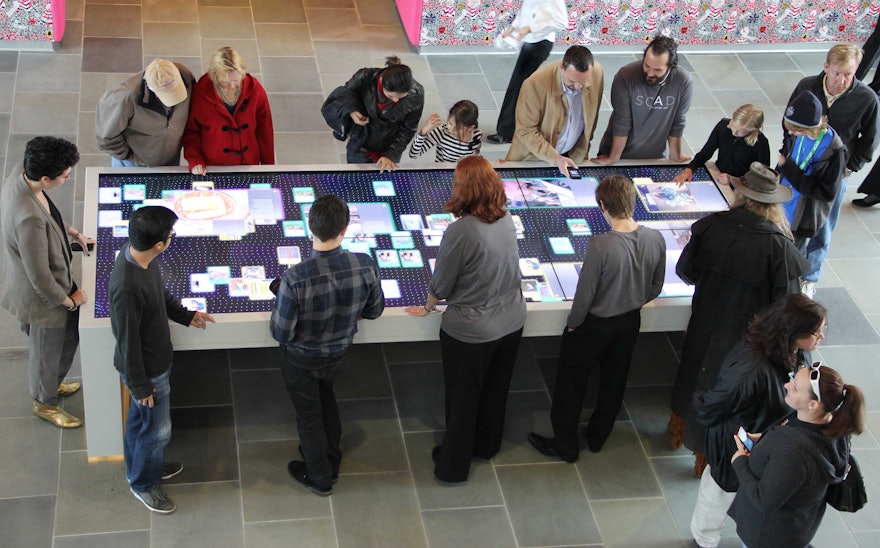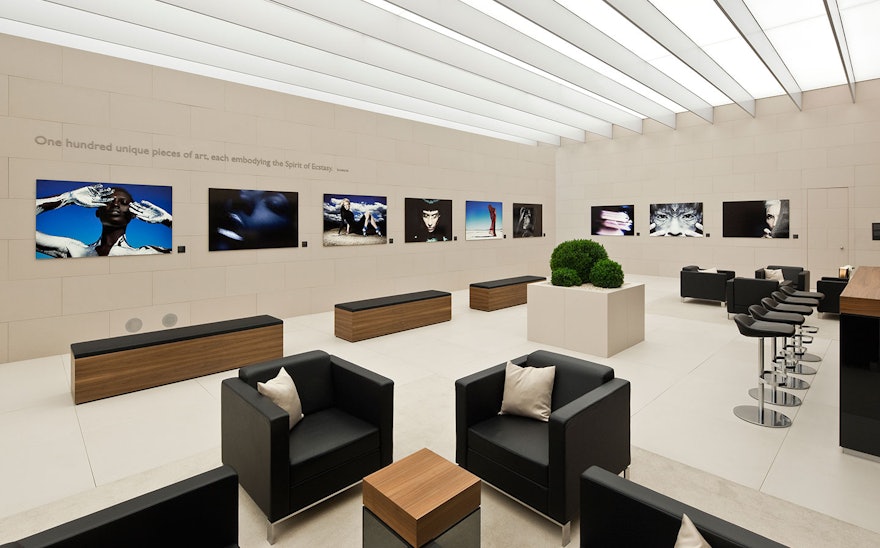An interactive installation can draw a user into an immersive experience, illuminating an exhibition or object in depth or detail. It may also foster interaction between users, creating a collaborative atmosphere that sets a welcoming social tone for an institution. For an expansion of the SCAD Museum of Art, the contemporary art and design museum at the Savannah College of Art and Design, Pentagram has created a unique interactive table that introduces the museum and its programs in a communal experience. Visitors gather around the table to view and exchange a series of “cards” that dynamically present information about the museum exhibitions, collections and programs.
Conceived by Pentagram, the communal table is an ideal form for the museum. SCAD supports a large community of students, artists, designers and educators in Savannah and beyond. The school is a pioneering institution with a campus of over 60 buildings spread throughout the city, many restored in the historic and Victorian districts. Designed by Savannah-based architects Sottile & Sottile, the new $26 million expansion adds 65,000 square feet to the existing 1856 Greek Revival building, originally the headquarters of the Central of Georgia Railway. The expansion creates additional galleries for the museum’s temporary exhibitions and permanent collection, new classrooms and performance spaces.
The designers worked closely with SCAD on the table’s development. The project moved quickly, taking only 5 months from concept to completion. The table has been installed in the museum lobby, where it welcomes visitors, providing a focal point to gather and share information about its programs. The table also helps attract students to SCAD, highlighting its expertise in interactive design and presenting works created at the school.
The table’s “cards” are a dynamic interface to share content and showcase the museum’s collections. Turning over a card—a gesture similar to flipping over a physical playing card—allows a user to view information about museum events and programs and peer into the archive. Scanning fingertips across the table, visitors can rotate the cards and slide them between users. Information is presented in both the cards’ large and small states. The cards get bigger when they are flipped over, and portfolios can be opened to view slideshows of images. The cards interact with the background and can attract or displace each other in groups. Users can also interact with the background, drawing lines and shapes on the screen’s surface. The card graphics tie into the museum’s existing identity.
The designers took a holistic approach to the table, considering it as a total product for its environment, not just a user interface. The industrial designer Robert Langhorn collaborated on the form, creating an elegant artistic object in its own right. The streamlined shape is made from a single sheet of metal that has been folded together. (The table was fabricated by Milgo Bufkin.) The table is 12 feet long, 5 feet wide and 34 inches high (it is ADA compliant) and is designed to be mobile so it can be moved for museum events.
The table utilizes U-Touch technology, and over 20 people can use it at once. (It is currently the world's largest mobile, freestanding interactive table.) Six 55” NEC screens were fit together and surrounded by an infrared bar that activates when it is hit. The screens are self-leveling, and a sheet of glass has been installed on top for protection. With only a 3 mm gap between the screens, the table has an almost seamless appearance.
To create the interface, the designers used the programming language C++, with a coding library called Cinder. Most of the program was written in Apple’s Xcode, and SCAD can develop its own programs for the table if it wishes. Museum staff can update the information presented in the cards using the ExpressionEngine content management system (CMS).

